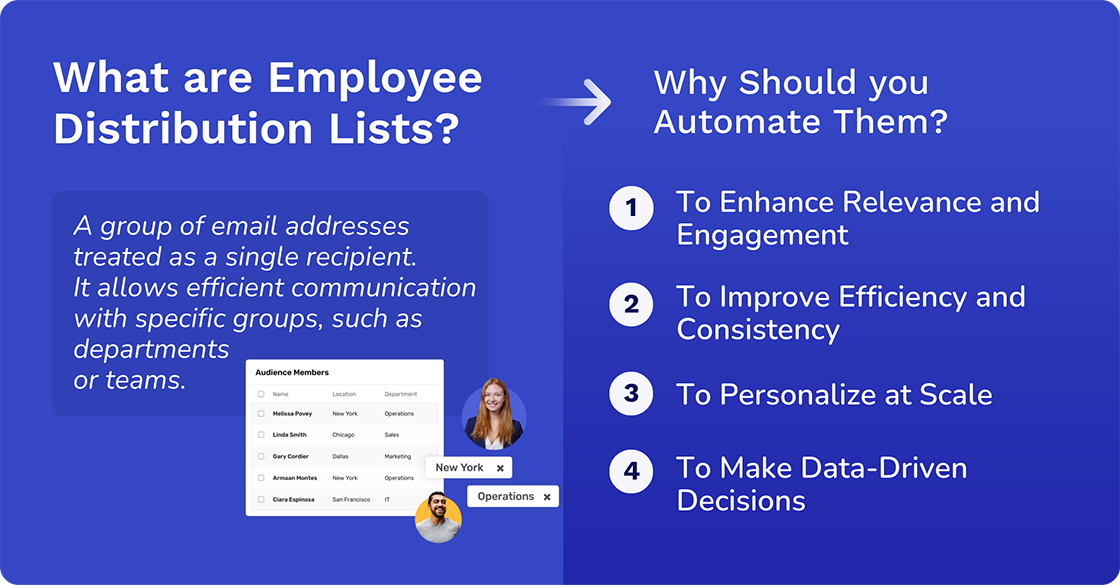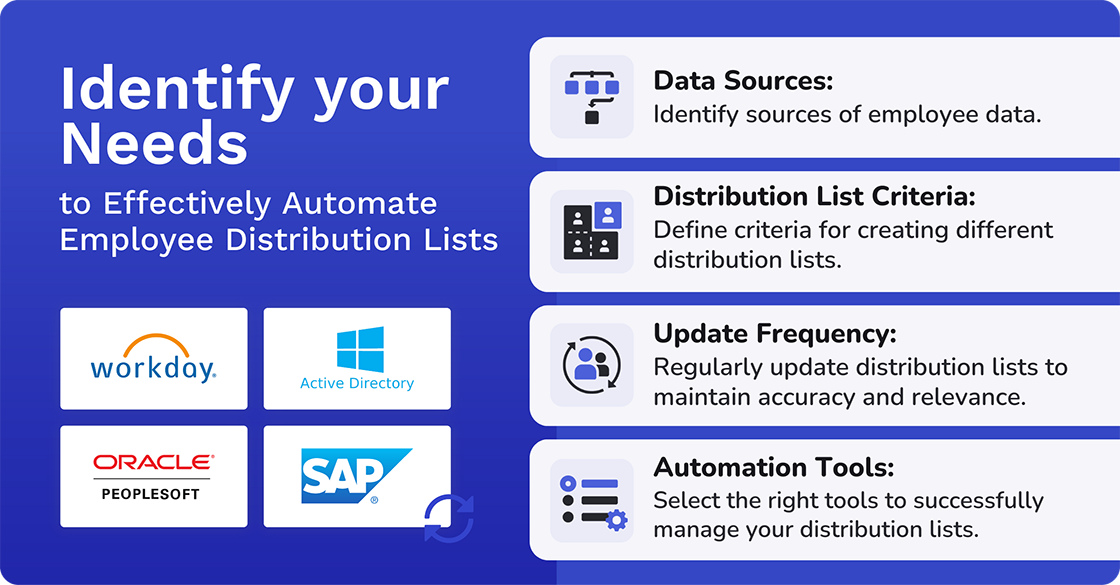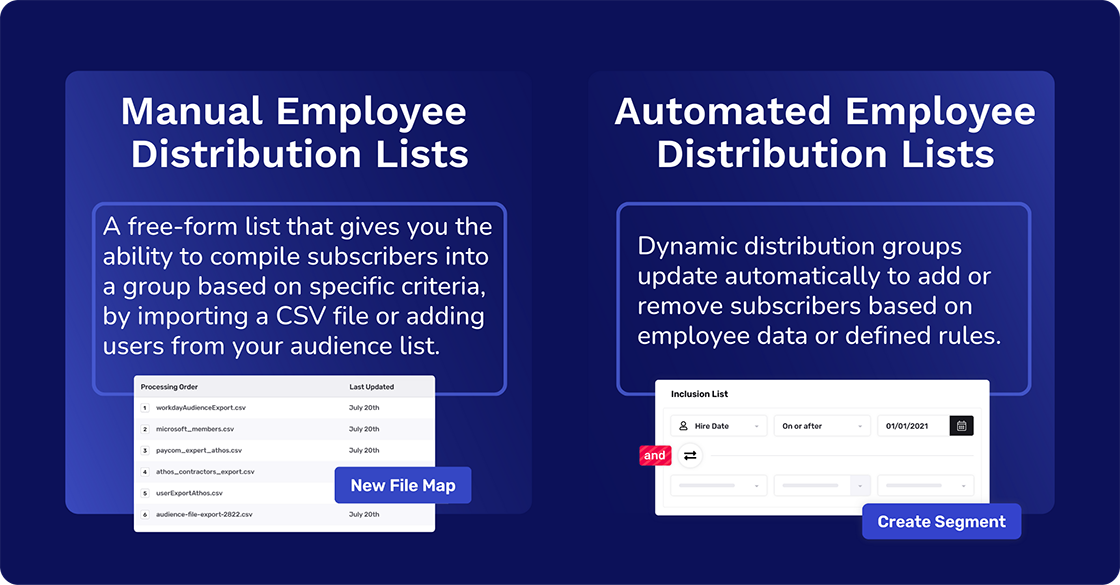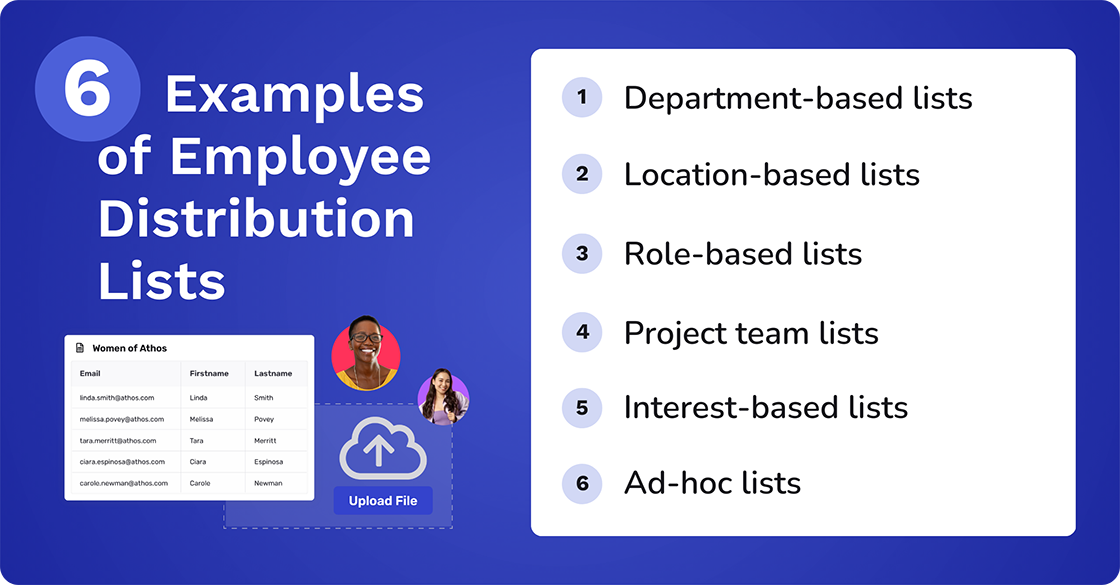Do you have employee distribution lists? If you don’t, be sure not to underestimate their value. We explain why and how to use them to streamline internal comms.

.webp)
Compare the features and capabilities of the top internal communication software platforms. Shop internal communication software with confidence knowing what you need and what these platforms provide.
Access NowEmployee distribution lists are a must-have in companies with more than 500 employees. Manually managing these employee email lists can be a time-consuming task that is prone to errors. Furthermore, manual management simply isn’t sustainable or efficient. As your organization grows, keeping these lists up-to-date becomes increasingly challenging.
Fortunately, automation can streamline this process and ensure accurate communication. However, manual work is still draining capacity. Many reports reveal many organizations still run on paper and spreadsheets. For instance, Alight’s Payroll in 2024 and beyond reveals that 51% use spreadsheets for payroll, and 19% use manual/paper payroll processes. The Hidden Costs of Manual Workforce Management: A CFMA 2025 Preview states, The manual collection, verification, and processing of timesheets consumes countless hours of administrative work.“ Furthermore, each step in manual processes significant administrative time and introduces opportunities for errors. They quote an American Payroll Association report that up to 8% of payroll entries contain errors when processed manually.
According to Deloitte’s 2025 Global Human Capital Trends, managers report spending nearly 40% of their time on administrative tasks, not on people or strategy. That’s a strong proxy for HR’s admin burden and supports your automation argument. However, at the same time, more than half (54%) of leaders and workers say they are concerned about the “blurred distinctions” between the work humans do and what is being done using technology. This is, of course, due to AI reshaping work by automating many tasks — but there is evidence that it is providing relief.
The Microsoft Work Trend Index Annual Report, 2025: The Year the Frontier Firm is born, states that 46% of leaders say their companies now use AI agents to fully automate workflows for entire teams or workflows. And IBM reports that its AskHR assistant contains 94% of routine HR queries.
Now that we’ve talked about the drawbacks of manual administration and the need for automation, let’s get back to basics in terms of internal email distribution lists.
Employee distribution lists are groups of employee email addresses that are treated as a single recipient. Their function is to allow efficient communication with specific groups, such as departments or teams. A common example is a list that contains all staff members for company-wide announcements. Another is a list of people managers, like supervisors and team leads, that is used for leadership updates and change communications. These are basically companies’ unique employee distribution lists that include everyone, though not all figure in every list.
More efficient employee email distribution lists will meet the needs of companies to efficiently send information to specific groups of employees, such as departments, teams, or roles. Think of them as dynamic distribution groups. This practice significantly improves internal communication by streamlining the process of sending mass emails and ensuring information reaches the intended audience without overwhelming individuals with irrelevant messages.
Ultimately, it becomes an integrated solution that combines multiple products, services, or components to solve a complex problem or fulfill a specific need. For example, an integrated customer relationship management (CRM) solution might combine sales, marketing, customer service, and support functions into a single platform like Cerkl Broadcast.
Employee email distribution lists streamline internal communication via the systematic grouping of employees based on specific criteria, such as department, role, location, or project team.
The process begins with data collection from various organizational sources, such as the HR system, directory service, payroll systems, and custom databases, followed by building a data warehouse to consolidate this information on employee email lists. These sources provide comprehensive employee information, including details about their roles, departments, locations, and other relevant attributes.
You can then use this data to define the criteria for segmenting employees into targeted groups. For example, you might choose to create separate lists for different departments, office locations, or employee roles to ensure that each group receives relevant and specific communications.
At Cerkl, we know that segmenting and automating your employee distribution lists is a game-changer for internal communications. Our Broadcast platform enhances relevance and engagement, improves efficiency and consistency, allows for personalization at scale, supports data-driven decision-making, and fosters a connected and informed workforce. It syncs in real time with HRIS systems and is entirely user-driven, taking mere seconds to complete.
By leveraging these strategies, you can ensure that your internal communications are not only effective but also impactful. This will help you build a more cohesive and motivated organization.
Segmenting your employee distribution lists allows you to tailor your communications to specific groups within your organization. By doing so, you can ensure that your messages are relevant to each audience, which significantly boosts engagement. When employees receive content that resonates with their roles, interests, and needs, they are more likely to read, understand, and act upon it.
For example, you can segment by:
Automation streamlines the process of distributing information, saving time and reducing the risk of human error. By automating your internal email lists for distribution purposes, you can ensure that the right people receive the right information consistently and on time. This is particularly useful for large organizations with multiple departments and locations.
Benefits include:
With automation, you can personalize communications at scale. Automated systems can utilize data like employee preferences, behavior, and feedback to tailor messages for individual recipients. This level of personalization fosters a sense of value and importance among employees, enhancing their overall experience.
Techniques include:
Automation tools often incorporate robust analytics capabilities that allow you to track and measure the effectiveness of communications. By analyzing data on open rates, click-through rates, and employee feedback, you can gain valuable insights into what works and what doesn’t. This data-driven approach enables you to make informed decisions and continuously optimize your communication strategies.
Metrics to track include:
Feedback scores: Assess employee satisfaction and areas for improvement.

To effectively automate your distribution lists, it’s crucial to have a clear understanding of your organization’s specific requirements by identifying your needs. This will ensure that your automation process is seamless, efficient, and tailored to meet your organization’s unique needs.
Here’s a detailed breakdown of key areas to consider:
Various employee data sources will enable you to identify where employee information is stored. The first step in automating your distribution lists is to identify these sources. The data is typically stored in systems across your organization.
Common data sources include:
By mapping out where your employee data is, you can ensure that your automation tools have access to accurate and up-to-date information.
Once you have identified your data sources, the next step is to define criteria for creating different distribution lists. This involves segmenting your employees based on various attributes that are relevant to your communication needs.
Common criteria include:
Defining clear and precise criteria for your distribution lists ensures that your communications are targeted and relevant.
The frequency with which you update distribution lists is a critical factor in maintaining their accuracy and relevance. Here’s what to consider when determining your update schedule:
It’s important to strike a balance between the need for up-to-date information and the technical and administrative overhead involved in updating your lists.
Align software for productivity and engagement

Selecting the right automation tools is crucial to the success of your distribution list management. When evaluating options, consider the following factors:
At Cerkl Broadcast, our AI-powered solutions are designed to meet these needs, offering robust automation capabilities that can be tailored to your organization’s unique requirements.

You can create employee distribution lists manually or dynamically with automation. Given our previous discussion about manual versus automated administration tasks, it stands to reason that an automated process will be quicker and probably more reliable. Nevertheless, you have the two options.
A manual segment is a free-form list that gives you the ability to compile subscribers into a group based on whatever criteria you want by importing a CSV (comma-separated value) file or adding users from your audience list.
You can update manual segments whenever you like. These lists will persist as created until you edit or delete them. This is what happens when you import distribution lists into Outlook emails or create Gmail Contact Groups.
Dynamic segments give you the ability to create rules that define a group of subscribers that you want to communicate with based on their unique attributes.
Your dynamic distribution groups will be updated automatically to add or remove subscribers based on their various data or rules. This means you don’t have to constantly clean up your lists and update your dynamic segments every time you want to use them.

Once you’ve chosen the right method and tools for automating your employee distribution lists, you can implement the automation process. There are several steps you will need to take.
Data mapping is a crucial first step in the automation process. It involves defining how employee data from various sources will be translated into your distribution list criteria. You will need to identify data fields, such as the department name, for example. Then create precise mapping rules for accurate list generation. It is also vital to ensure consistency of data.
With your data mapping in place, the next step is to create your distribution lists. Utilize automation tools to build and update distribution lists based on defined criteria. Set parameters for inclusion and exclusion, and update frequency.
Before rolling out the automated distribution lists organization-wide, it’s essential to test the process thoroughly to ensure accuracy and reliability.
Ongoing monitoring is crucial to ensure the continued accuracy and effectiveness of your automated distribution lists. Continuously check for errors and inconsistencies, and implement regular checks to maintain list accuracy.
Align software for productivity and engagement

Here are some common types of employee distribution lists you might consider:

Cerkl Broadcast eliminates the need for static distribution lists. Instead, the platform lets you leverage the power of segmentation and streamline automation. Importantly, Audience Manager allows you to create Dynamic Segments that are always live. These connect seamlessly with your HR system, updating based on the rules users prescribe. It’s all automatic.
Broadcast also lets you target lists across all your communication channels. Furthermore, you can create either Manual or Dynamic Segments.
As employee data changes in your HR system, Broadcast automatically updates the Segments in real time. When crafting emails, News Digests, or announcements, simply select the relevant Segment to ensure only the intended recipients receive your message.
How about building internal email distribution lists that manage themselves? Static, manual lists go stale fast, leading to missed updates and extra rework. With Cerkl Broadcast, you can create rules-based segments once and let our Audience Manager keep them current as people join, move teams, or leave. Dynamic segmentation ensures the right employees get the right message every time. Furthermore, our real-time communications analytics shows exactly who you reached and what landed, so you can improve with each send.
To make getting started simple, we’ve introduced a free Foundations Subscription Tier. The plan is designed to allow you to test Broadcast’s core capabilities, including the Email Builder, Audience Manager, and Email Analytics. You can include three team members and you’ll be able to send up to 5,000 employee emails per month.
Stop maintaining lists by hand. Try Broadcast free today and see how segmentation plus automation streamlines internal email. Download No

Align software for productivity and engagement

Align software for productivity and engagement